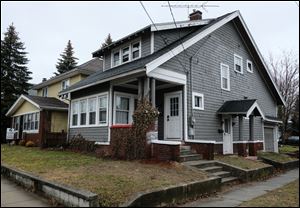
Landlords sue Bowling Green over tenant restrictions
2/24/2018Editor's note: This story has been updated to reflect that BGSU has built increased on-campus housing as enrollment has increased.
BOWLING GREEN — Rose Hess has lived in her east-side Bowling Green home since 1964, when she arrived in the city as a graduate student. As Bowling Green State University's enrollment has increased since then, the university built more on-campus housing to meet demands, and many students have moved into the city's rental market..
Many have moved into single family homes, but a 1975 Bowling Green zoning ordinance caps the number of unrelated individuals at three, regardless of the size of the home. That rule ensnared Alex Kuczma, one of three BG tenants now suing the city.
“When we moved in we had no idea that we would run into any issues,” Mr. Kuczma said. “It really just seems like the city of BG is anti-student, by giving us these unnecessary problems along with receiving several costly tickets for small gatherings at our house.”

A home on E. Merry Avenue in Bowling Green, Ohio. A Bowling Green zoning ordinance capping the number of unrelated individuals living in a home is the subject of a lawsuit against the city.
Mr. Kuczma, along with his fellow housemates Grant Yoder and Grady Wildman, are represented by their landlord, Maurice Thompson, who is also a plaintiff in the case. They are joined by more than 20 landlords claiming to own 161 rental homes in the city.
“The city is not allowing five unrelated people to live in a five-bedroom home,” said Andrew Mayle, co-counsel for the plaintiffs, calling it a form of economic discrimination.
The case is pending in federal court, with the judge yet to rule on the city’s motion to oppose an amended complaint, which also asks the court to dismiss the complaint entirely on standing and ripeness issues. The city had, in previous filings, also claimed the ordinance is a valid exercise of the city’s power.
The East Side Residential Neighborhood Group, co-founded by Ms. Hess, considered intervening in the lawsuit on behalf of the city, but instead settled on sending a letter to U.S. District Court Judge Jack Zouhary, the judge in the case.
“We are deeply concerned with this case because it challenges the right of the City to create such zones which provide “a sanctuary for people,” the letter reads in part, quoting a 1974 Supreme Court decision that provided the basis for the city’s zoning rule. “If the plaintiffs prevail, this would open a floodgate and would be a step backward and defeat all that the City Administration and residents have worked for.”
That is not what Mr. Mayle hopes to see as a result of the lawsuit. Instead, he wants the city to tie its occupancy limits to a more objective standard, like the number of bedrooms or the availability of parking spots on the property.
Additionally, the east-side group is concerned about further degradation of property values in the area, which collectively has already lost $54 million in value because of disproportionate student living, according to a 2014 study.
That can be addressed in different way that does not put the burden of figuring out who is or is not related squarely on a landlord, said Anna Mills, the president of the Toledo Real Estate Investors Association and past president of the national REIA.
Of the 65 properties she owns, less than one-third are occupied by the sort of traditional blood-family with a shared last name. The number of nuclear families broken up by drug addiction are rising, she said. So while everyone in a home is related, not having matching last names makes it hard to tell who is or is not related.
Besides, if cities want to control the raucous parties that come with college students packed into a neighborhood, there are laws on the books to do just that, she said.
“If you have nuisance complaints, you can take care of it that way,” Ms. Mills said.
Multiple police calls to the plaintiff’s property in Bowling Green caught the attention of the city zoning office, which launched its own investigation, according to the enforcement letter sent to Mr. Thompson. Jason Westgate, the city’s code enforcement officer and the lone named defendant in the case, signed the letter.
When reached by phone, Mr. Westgate declined to comment, and directed any questions to William Lang, the attorney representing both him and the city. He declined to comment on pending litigation.
The city of Toledo has a similar ordinance, although enforcement action is rare, city spokesman Ignazio Messina said.
“It’s really difficult to prove,” Mr. Messina said. “Most cities don’t have the resources to stake out outside a house.”
The city also faced a similar lawsuit in state court. The Ohio 6th District Court of Appeals upheld the city’s law in 2004.
Mr. Mayle is unsure how frequently or infrequently the law is enforced, which is part of his complaints about the ordinance.
“They seem to want to terrorize landlords whenever they get around to it,” he said.
But for Ms. Hess, enforcing this aspect of the city’s zoning code is vitally important to her quality of life.
“The majority of students are great,” she said. “A small number make it miserable for permanent residents.”
Contact Zack Lemon at zlemon@theblade.com, 419-724-6282 or on Twitter @zack_lemon.